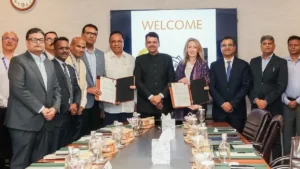The Indian Olympic Association (IOA) has chosen Uttarakhand as the host for the 38th Summer National Games, scheduled to take place from 28th January to 14th February 2025. This announcement marks a significant achievement for the state, as it will be hosting the prestigious event for the first time, followed by the upcoming Winter Games, which will be held outside Jammu & Kashmir and Ladakh for the first time.
The 37th National Games, held in Goa from 25th September to 9th November 2023, paved the way for Uttarakhand’s momentous turn to showcase its capabilities on the national sporting stage.
Uttarakhand to Host 38th National Games
Uttarakhand, a state known for its natural beauty and thriving tourism, will now enter the national spotlight for sports with the 38th National Games. These games will serve as a platform to showcase sporting talent from across India and further develop Uttarakhand’s sports infrastructure.
According to the Indian Olympic Association (IOA), the 38th National Games will take place from 28th January to 14th February 2025. However, the specifics regarding the venue, events, and other schedules are expected to be confirmed during the IOA’s General Assembly meeting on October 25, 2024.
A New Era for Winter Games
For the first time in history, the Winter Games will be hosted outside the regions of Jammu & Kashmir and Ladakh, traditionally associated with winter sports in India. This development opens up new possibilities for Uttarakhand, already known for its mountainous terrain and cold-weather conditions, to establish itself as a hub for winter sports in the country.
About the National Games
The National Games of India are a significant multi-sport event organized by the Indian Olympic Association and hosted by different state governments. The National Games follow the Olympic model, with the primary goal of identifying and nurturing sporting talent in India. The athletes who participate in the National Games are often considered future representatives of India in the Summer Olympics and other international sporting events.
Originally known as the All-India Olympic Games, the first edition was held in 1924 in Lahore (now in Pakistan). The name was officially changed to the National Games during the 9th edition in Bombay (now Mumbai) in 1940.
Evolution of the National Games
The National Games were initially held every two years, with regular editions up until the 24th National Games. However, after that, the games have been held irregularly, largely due to logistical and financial constraints faced by hosting states.
Below is a detailed table of the National Games held so far, including the host cities, states, and the years in which they were conducted:
| Edition | Year | Host City/State |
|---|---|---|
| 1 | 1924 | Lahore (now in Pakistan) |
| 2 | 1926 | Lahore |
| 3 | 1928 | Lahore |
| 4 | 1930 | Allahabad |
| 5 | 1932 | Madras (now Chennai) |
| 6 | 1934 | New Delhi |
| 7 | 1936 | Lahore |
| 8 | 1938 | Calcutta (now Kolkata) |
| 9 | 1940 | Bombay (now Mumbai) |
| 10 | 1942 | Patiala |
| 11 | 1944 | Lahore |
| 12 | 1946 | Lahore |
| 13 | 1948 | Lucknow |
| 14 | 1952 | Madras (now Chennai) |
| 15 | 1953 | Jubbulpore (now Jabalpur) |
| 16 | 1954 | New Delhi |
| 17 | 1956 | Patiala |
| 18 | 1958 | Cuttack |
| 19 | 1960 | New Delhi |
| 20 | 1962 | New Delhi |
| 21 | 1964 | Calcutta (now Kolkata) |
| 22 | 1966 | Bangalore (now Bengaluru) |
| 23 | 1968 | Madras (now Chennai) |
| 24 | 1970 | Cuttack |
| 25 | 1979 | Hyderabad |
| 26 | 1985 | New Delhi |
| 27 | 1987 | Kerala |
| 28 | 1994 | Bombay (now Mumbai) & Pune |
| 29 | 1997 | Bangalore & Mysore |
| 30 | 1999 | Imphal (Manipur) |
| 31 | 2001 | Punjab |
| 32 | 2002 | Andhra Pradesh |
| 33 | 2007 | Guwahati |
| 34 | 2011 | Jharkhand |
| 35 | 2015 | Kerala |
| 36 | 2022 | Gujarat |
| 37 | 2023 | Goa |
| 38 | 2025 | Uttarakhand |
Summary of the News
| Summary/Static | Details |
| Why in the news? | The Indian Olympic Association (IOA) has chosen Uttarakhand as the host for the 38th Summer National Games, scheduled to take place from 28th January to 14th February 2025. |
| 38th Games Mascot | Himalayan Monal, the state bird of Uttarakhand |
| Previous Edition | Goa |
| Previous Edtion winner |
Maharashtra: 80 Gold, 69 Silver, 79 Bronze (Total: 228) |
| Static |
|




 Tamil Nadu Adds Five New Products to Its...
Tamil Nadu Adds Five New Products to Its...
 Uttarakhand Foundation Day 2025: Celebra...
Uttarakhand Foundation Day 2025: Celebra...
 Maharashtra Signs Landmark Deal With Sta...
Maharashtra Signs Landmark Deal With Sta...







